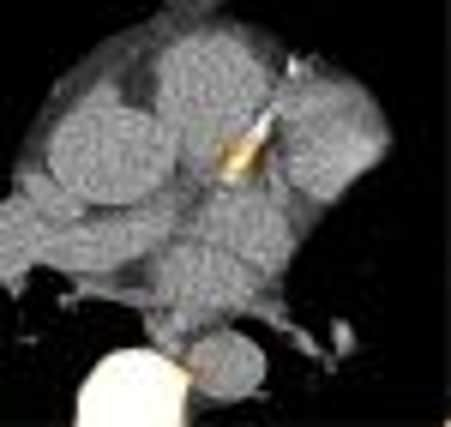New scans will predict heart attacks before they happen, hope doctors


The method developed by medics at Edinburgh University combines the use of CT scans and special X-ray images to pick up dangerous levels of the calcium that blocks arteries.
Tests on more than 100 patients found the state-of-the-art pictures successfully identified those most at risk of cardiovascular disease.
Advertisement
Hide AdAdvertisement
Hide AdIt is the first time the processes that cause heart attacks have been captured directly in the coronary arteries.
Dr Marc Dweck, of Edinburgh University’s Centre for Cardiovascular Sciences, said: “If we can identify patients at high risk of a heart attack earlier, we can then use intensive drug treatments and perhaps procedures such as stents to reduce the chances of them having a heart attack.”
There are nearly 2.7 million people living with coronary heart disease in the UK, and it kills 88,000 people each year.
Dr Dweck said: “The first presentation of cardiovascular disease is often a heart attack or sudden death.
“If we can get to these people before this happens, it is easy to see how we could save a great number of lives.”
The researchers, whose findings are published today in the Journal of the American College of Cardiology, measured each participant’s calcified, or hardened, plaques in their arteries by giving them a standard CT scan.
This is commonly used to predict heart disease risk but cannot distinguish calcium that has been there for some time from that which is actively building up.
The patients were also injected with two special molecules that show up on images and can be used to track substances in the body.
Advertisement
Hide AdAdvertisement
Hide AdOne of these “tracers”, 18F-NaF (18F-sodium fluoride), is a chemical taken up by cells in which active calcification is occurring and can be picked up and measured on special scans.
The researchers wanted to see if they could identify patients with active, ongoing calcification because these may be at higher risk than those in whom the calcium developed a long time ago.
The results showed increased 18F-NaF activity could be observed in specific coronary artery plaques in patients who had many other high-risk markers of cardiovascular disease.
Dr Dweck said: “Our technique holds a lot of promise as a means of improving heart attack prediction, although further ongoing work is needed before it becomes routine clinical practice.”
The researchers are carrying out a follow-up study involving 80 people – half of whom have suffered a heart attack and the others cardiovascular disease patients – to study the differences in their imaging scans.
Dr Dweck added: “It is early days, but the results are looking good so far. Then we will be looking at a large-scale internation study.”
If all goes well, the technique could be in clinical use within five years.
Dr Dweck and his colleagues also plan to translate their technique into predicting a patient’s risk of a stroke.
Advertisement
Hide AdAdvertisement
Hide AdDr Shannon Amoils, research adviser at the British Heart Foundation, which funded the study, said: “For decades, cardiologists have been looking for ways to detect the high-risk plaques found in coronary arteries that could rupture to cause a heart attack, but it’s been difficult to develop a suitable imaging test that can focus in on these small vessels.
“This research is a technical tour de force as it allows us to assess active calcification happening right in the problem area – inside the wall of the coronary arteries and this active calcification may correlate with a higher risk of a heart attack.”